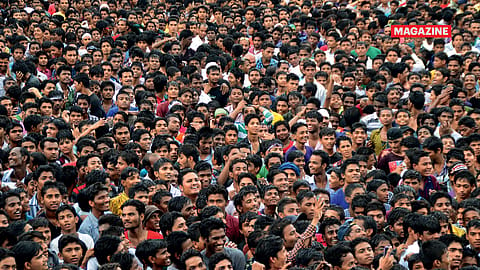Will NBFCs be able to drive the consumption credit landscape, writes Vishal Kampani
If NBFCs succeed in striking a balance between growth impulse and diligence, they could well become the force to reckon with in financing India’s consumption story.

This story belongs to the Fortune India Magazine global-brands-indian-sheen issue.
AMIDST THE U.S. TARIFF LEVY, a consistent rise in customer spending has emerged as a resilient growth engine for India. The data mentioned in a recently released report by the Ministry of Finance reflects that underlying theme. According to the report, the share of private consumption in nominal GDP rose to 61.4% in FY25 from 60.2% in FY24. The report projected a positive growth outlook as well. According to the report, the share of ‘Middle India’ i.e. households with annual income of ₹2-10 lakh is expected to steadily increase — from 103 million middle-income households in FY22 to 181 million by FY30. Buoyed by all these catalysts, including growing consumerism, India is steadily progressing towards emerging as the world’s consumption capital. The scale, speed, and evolution of the credit ecosystem will give a further flourish to the consumption story.
The evolving borrowing habit adds to the vibrant credit ecosystem in the country. Be it buying a home, owning high-end smartphones or booking vacation packages, people now have developed a certain comfort level while opting for borrowing. Recent data from GlobalData’s Global Retail Banking Analytics shows that consumer loan values in India surged by 27.6% owing to rising incomes and shifting spending patterns. Even in the middle of a challenging global and domestic environment, the value of consumer loans grew approximately 8.3% in 2024 to reach $690.5 billion. Consumption lending now accounts for about 54% of the total lending market, according to CRIF Highmark.
However, the pace of disbursement has moderated across categories in FY25, ranging from -3% to 11%, compared to 5% to 25% in FY24. This moderation will inevitably weigh on FY26 loan progression. Nevertheless, NBFCs and housing finance companies (HFCs) have gained market share, while private banks have ceded ground across segments.
Why NBFCs are gaining ground
NBFCs have carved a niche in the consumption credit space with deeper demographic understanding, broader reach, customised product offerings, faster turnaround time and greater risk management. Many NBFCs have also been early adopters of new-age technologies, data-driven and digital platforms. With the development of digital infrastructure, these NBFCs are in a better position to cater to underserved and new-to-credit customers.
While private and public sector banks still dominate overall credit volumes, NBFCs have strengthened their position in segments such as retail finance, vehicle finance, personal loans, and affordable housing. Some of these categories often act as the first touch-points for aspiring consumers. With fast and convenient credit access, NBFCs complement the aspirations of the country’s young population.
Although urban consumption may be showing signs of fatigue, rural demand remains resilient on the back of a good monsoon. NBFCs with their customised offerings are equipped to tap into semi-urban and rural markets where banking infrastructure is not well spread out. In fact, NBFCs have overtaken banks when it comes to the rise in credit outstanding on the back of a widespread branch network, product innovation, and the proliferation of digital technology. The convergence of aspirations, access, and availability of credit builds the growth runway for NBFCs
More Stories from this Issue
The opportunity ahead
Looking ahead, certain macroeconomic tailwinds could strengthen the consumption credit landscape. Inflation is under control with the Consumer Price Index (CPI) for July 2025 touching a five-year low. A cut in the repo rate and recently announced GST reforms will boost buying power and discretionary purchases. Digital public infrastructure such as Aadhaar, UPI, etc., has paved the way for frictionless onboarding and smooth disbursals.
The growth of e-commerce and digital marketplaces has created new avenues of consumption, many of which are credit-enabled. In such a scenario, NBFCs are poised to further expand their footprint, physically, digitally or phygitally, in discretionary categories such as travel, electronics, and lifestyle products.
The risks to watch
(INR CR)
However, asset quality in unsecured lending in particular needs close monitoring. Rapid expansion without robust risk management could potentially tighten the operating environment. Moreover, banks are upping their ante. Many have ramped up their digital lending capabilities by collaborating with fintechs, apart from sharpening their focus on enhancing customer experience. Consumer credit is becoming the new battleground for banks and NBFCs.
A balanced outlook
NBFCs will continue to play a vital role in shaping India’s consumption credit landscape on the back of growing financial inclusion and favourable policy interventions. Their agility, risk-taking ability, and wider reach to cater to underserved markets with hyper-personalisation of services, product, and lending model innovation approach give them an edge.
However, NBFCs need to balance speed with due diligence, embrace data-driven risk management, and invest in long-term customer relationships. The growing credit demand will not only test the resilience and adaptability of their business models but also their ability to innovate diligently and exercise caution, and maintain lending discipline to avoid the repeat of the post-pandemic extraordinary uptick in consumption-driven credit. If NBFCs succeed in striking a balance between growth impulse and diligence, they could well become the force to reckon with in financing India’s consumption story.
(Views are personal.)